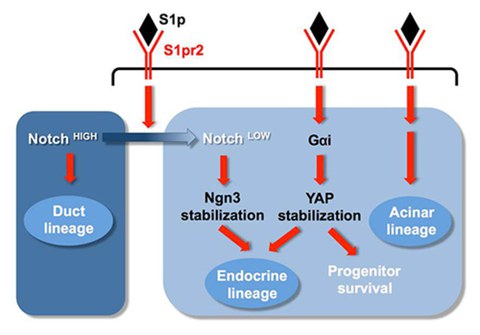Pancreas lineage allocation and specification are regulated by...

(c) PLID
Sphingosine-1-phosphate has a key role in mouse pancreas progenitor survival and the generation of the endocrine and acinar lineages. S1p signaling promotes endocrine specification by stabilizing YAP and attenuating Notch signaling.
The pancreas develops from a field of progenitor cells localised in a restricted region of the embryonic endoderm. These progenitor cells proliferate and eventually differentiate to generate the three distinct lineages comprising the endocrine (which include insulin-producing β cells), acinar, and ductal cells. DZD-Reseachers show that a phospholipid, sphingosine-1-phosphate (S1p), generated by the progenitor cells themselves, acts as a signal necessary to define the acinar and endocrine lineage. They observe that in the absence of S1p only duct cells are generated and the survival of pancreas progenitors is compromised.
The function of this signalling pathway in the generation of the endocrine cells is two-fold. Firstly, it stabilizes yes-associated protein (YAP), a transcriptional gene coactivator known to regulate pancreatic progenitor proliferation. The reseachers show that this stability is necessary for the activation of the endocrine specification program. Secondly, it attenuates Notch signalling, allowing the generation of endocrine and acinar cells. Notch attenuation is necessary for the stabilisation of the transcription factor Ngn3, which is required for the generation of endocrine cells.
The DZD-Reseachers conclude that S1p acts as an autocrine signal regulating YAP stabilization and Notch attenuation to mediate pancreas specification. Understanding lineage allocation and specification in the pancreas will shed light on the origins of pancreatic diseases and may suggest novel therapeutic approaches.
Original publication:
Serafimidis I., Rodriguez-Aznar E., Lesche M., Yoshioka K., Takuwa Y., Dahl A., Pan D., Gavalas A.
Pancreas lineage allocation and specification are regulated by sphingosine-1-phosphate signalling.
PLoS Biol. 2017 Mar 1;15(3):e2000949. doi: 10.1371/journal.pbio.2000949. eCollection 2017.
